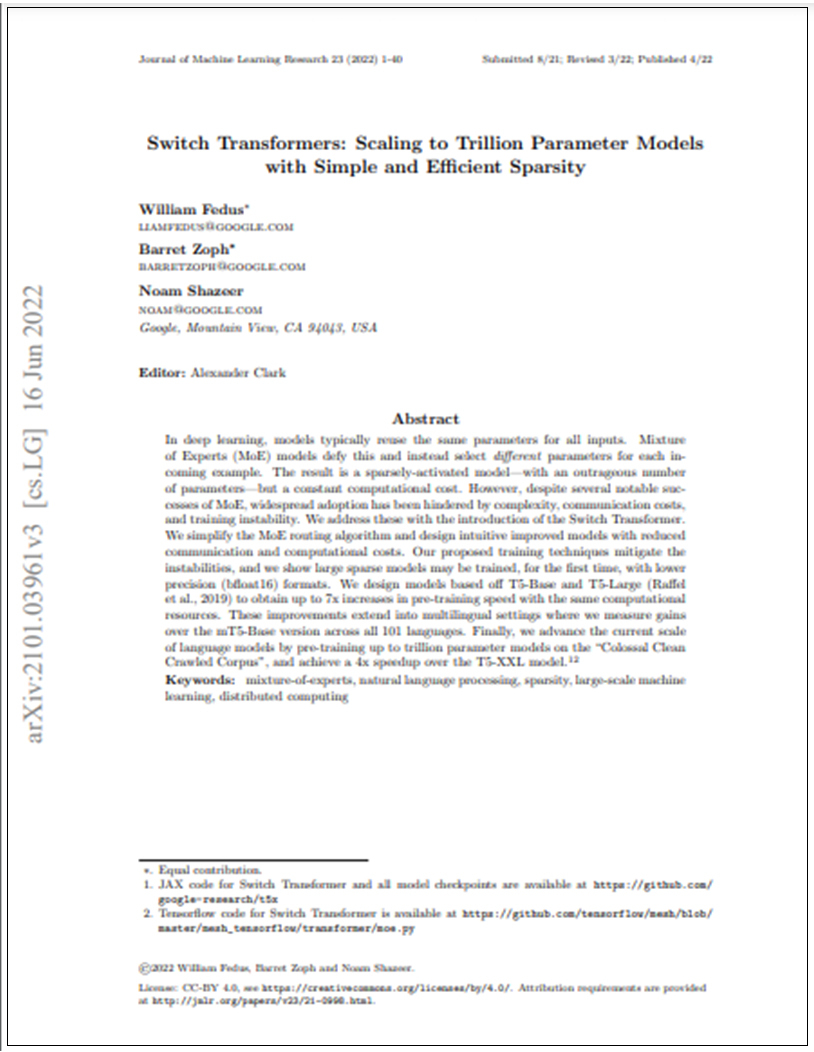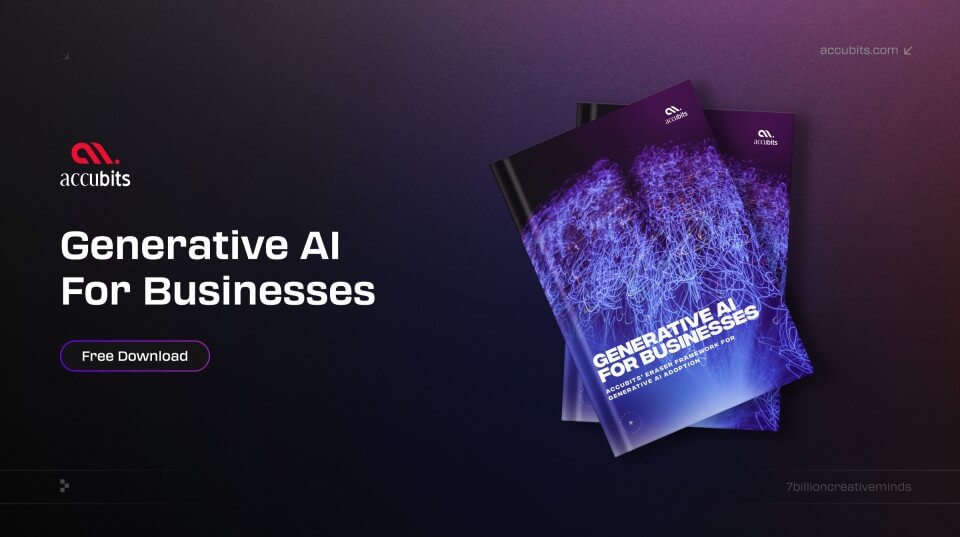

LLMs Explained,
Switch Transformer
The Switch Transformer is a neural architecture for sequence modeling tasks that was introduced in a paper by Google Brain researchers in 2021. The architecture is based on the Transformer model, which is a popular architecture for sequence modeling tasks such as language translation and text generation. The Switch Transformer extends the Transformer model by introducing a novel mechanism for dynamically routing information through different layers of the model. This mechanism, called the Switch mechanism, allows the model to selectively attend to different parts of the input sequence, and to dynamically adjust the attention weights based on the context of the input.
Model Card View All Models
View All Models 
100+ Technical Experts

50 Custom AI projects

4.8 Minimum Rating
An Overview of Switch Transformer
The Switch Transformer is a novel neural architecture for sequence modeling tasks that was introduced in a paper by Google Brain researchers in 2021.
Scales up to 1.6T parameters and improves training time!
1.6T Parameters
The Switch Transformer scales up to 1.6 Trillion parameters and improves training time up to 7x compared to the T5 NLP model
The model achieved 4x speedup over the T5-XXL model.
4X Faster
Model advance the scale of language models on the “Colossal Clean Crawled Corpus”, achieves 4x speedup over the T5-XXL model.
Achieved a speedup of 1.35x over the previous models
46.5 BLEU score
On the WMT14 English-German translation task, it achieved a BLEU score of 46.5, outperforming previous best by 1.3 points.
Blockchain Success Starts here


-
Introduction
-
Business Applications
-
Model Features
-
Model Tasks
-
Getting Started
-
Fine-tuning
-
Benchmarking
-
Sample Codes
-
Limitations
-
Other LLMs
About Model
Switch Transformer is a recent neural architecture for sequence modeling that extends the popular Transformer model. It introduces sparsity into transformer attention mechanisms, dividing the attention matrix into smaller matrices that can be computed independently, making inference faster and more memory-efficient. The model's sparsity allows it to scale to much larger sizes, potentially reaching trillions of parameters. Switch Transformers has shown promising results on several benchmarks, including machine translation, language modeling, and speech recognition, and includes a "switch" mechanism for dynamically adjusting the level of sparsity in the attention mechanism based on input. This mechanism enables greater efficiency without sacrificing accuracy, and the model has been shown to enable faster training and better fine-tuned task performance than T5.
Model highlights
Following are the key highlights of the Switch Transformer model.
- Simplifies the Mixture of Experts routing algorithm
- Reduced communication and computational costs
- Mitigates instabilities in training techniques
- Allows for the training of large sparse models
- 7X pre-training speed with the same computational resources
- Improvements in multilingual settings across all 101 languages
- Achieves a 4x speedup over the T5-XXL model

Training Details
Training data
The model was trained on a Masked Language Modeling task, on Colossal Clean Crawled Corpus (C4) dataset, following the same procedure as T5.


Training Procedure
According to the model card from the original paper the model has been trained on TPU v3 or TPU v4 pods, using t5x codebase together with jax.


Training dataset size
The exact size of the training dataset used to train the Switch Transformer is not provided in the original paper. However, it is mentioned that the model was pre-trained on large amounts of text data, including web pages and books


Training time and resources
The model was trained on a massive compute cluster with 256 GPUs and 2048 TPUv3 cores. The training took about a week, much less than the several weeks required to train the T5 model on a comparable number of TPUv3 cores.


Model Types
Switch-C, Switch-H, and Switch-S are three versions in the family of Switch Transformers that were created to satisfy various performance and computational needs. Switch-H is tailored for effective inference on memory-constrained hardware, Switch-S is a smaller-scale architecture made for quick experimentation and prototyping, and Switch-C is a high-performing model with 1.6 trillion parameters.
| Model | Parameters | Highlights |
| Switch-C | 160 billion | language modeling |
| Switch-H | 160 billion | Efficient inference |
| Switch-S | Small-scale | Fast experimentation |
Business Applications
Switch Transformer is a useful tool for companies trying to harness the power of AI because it can be utilised in any application that calls for the processing of vast volumes of data and can gain from better computational and memory efficiency.
| Language Modeling | Question Answering |
| Machine translation | Customer support |
| Content generation | Knowledge management |
| Sentiment analysis | Decision support systems |
| Text summarization | Information retrieval |
| Spell and grammar checking | Healthcare diagnostics |
| Recommendation systems | Legal research |
| Virtual assistants | Marketing intelligence |
| Fraud detection | Threat analysis |
| Predictive analytics | Human resources management |
| Speech recognition | Financial analysis and forecasting |
Model Features
The model incorporates innovative techniques that make it more effective and scalable than conventional transformers, including dynamic routing, sparsity, and parallelization. It can also be pre-trained on substantial volumes of unlabeled data, improving its capacity to carry out downstream tasks.
Dynamic Routing
The Switch Transformer introduces a novel mechanism for dynamically routing information between different computational blocks, allowing it to handle varying degrees of context dependence and long-term dependencies.
Sparsity
The model uses sparse connections between layers, resulting in a more efficient and scalable architecture.
Parallelization
The Switch Transformer can be easily parallelized across multiple GPUs or TPUs, allowing it to quickly process large amounts of data.
Pre-training
Like other transformer models, the Switch Transformer can be pre-trained on large amounts of unlabeled data, improving its ability to perform downstream tasks.
Pre-trained checkpoints
Several pre-trained Switch Transformer checkpoints are available on the Hugging Face Transformers library, which provides a high-level API for working with various pre-trained transformer models, including the Switch Transformer. The available checkpoints include different model sizes, ranging from XS to XL, and were pre-trained on different text corpora.
Level of customization
The Switch Transformer can be customized to suit specific use cases. For example, the model can be fine-tuned on task-specific datasets to improve its performance on specific tasks. The model can also be modified to add or remove layers, change the number of attention heads, or adjust other hyperparameters.
Licensing
The Switch Transformer was developed by Google and is available under the Apache 2.0 open-source license. This model can be freely used, modified, and distributed as long as the license terms are followed.
Model Tasks
Switch is a cutting-edge language model capable of performing a wide range of natural language processing tasks. This model has been trained on large datasets such as XSum, ANLI, and ARC to ensure it can handle a wide range of natural language inputs and generate accurate, contextually appropriate responses. Switch represents the future of natural language processing technology.
Cross-Lingual text Summarization
The model can summarize the text in different languages and provide a summary in a target language. This task is useful for summarizing documents, news articles, or other types of text written in languages other than the user's native language. For example, a Spanish user may use Switch to summarize an English news article.
Reasoning under adversarial conditions
The model can make logical deductions and conclusions even when presented with adversarial inputs to mislead or confuse the model. This task is important for security and reliability, as adversaries may attempt to manipulate the input data to cause the model to produce incorrect outputs.
Elementary school science question answering
The model can answer basic science questions typically taught in elementary school. This task is useful for educational purposes, as it allows students to get quick and accurate answers to science questions.
Advanced science question answering
The model can answer complex scientific questions across various domains such as physics, chemistry, and biology. This task is useful for researchers, scientists, and other professionals who need to quickly and accurately find answers to scientific questions.
Common sense reasoning
The model can apply common sense knowledge and reasoning to interpret and understand natural language text. This task is important for natural language understanding, as it enables the model to understand and generate contextually appropriate and semantically meaningful text.
Question answering
The model can answer factual questions by generating responses based on the input context. This task is useful for various applications, such as customer service chatbots, virtual assistants, and search engines.
Getting Started
You can still use the model by either building it from scratch or using a third-party implementation. Here are the steps to install the Switch Transformer:
- Install the necessary libraries
- Load the pre-trained Switch Transformer model
- Tokenize your input data
- Pass the tokenized input to the model to get the output
!pip install tensorflow !pip install numpy !pip install transformers
import transformers
<meta charset='utf-8'>model = transformers.AutoModel.from_pretrained('google/switch-transformer-xs')
tokenizer = transformers.AutoTokenizer.from_pretrained('google/switch-transformer-xs')
<meta charset='utf-8'>inputs = tokenizer('input sentence', return_tensors='tf')
outputs = model(inputs)
You can further process or analyze the output to obtain the desired result. This implementation uses the Hugging Face Transformers library, which provides a high-level API for working with pre-trained transformer models, including the Switch Transformer. This simplifies the implementation process and reduces the time and effort required to build the model from scratch. To use the library, you can follow these steps:
- Install the Hugging Face Transformers library using pip: pip install transformers
- Load the pre-trained Switch Transformer model: model = transformers.AutoModel.from_pretrained ('google/switch-transformer-xs')
- Tokenize your input data: inputs = tokenizer('input sentence', return_tensors='tf')
- Pass the tokenized input to the model to get the output: outputs = model(inputs)
- Perform any further processing or analysis on the output
Note that the above steps are just an example, and you may need to modify them depending on your specific use case. Also, choose the appropriate pre-trained Switch Transformer model size based on your requirements.
Fine-tuning
Here are some of the available fine-tuning techniques or methods for Switch Transformers:
Transfer Learning
Transfer learning involves taking a pre-trained Switch Transformer model and adapting it to a new task or dataset through fine-tuning. By leveraging the pre-trained model's knowledge, transfer learning can significantly reduce the labeled data required for training and improve the model's performance.
Multi-Task Learning
Multi-task learning involves training a Switch Transformer model to perform multiple related tasks simultaneously. By sharing the parameters of the model across multiple tasks, multi-task learning can improve the model's performance on each task and reduce the amount of training data required for each task.
Curriculum Learning
Curriculum learning involves gradually increasing the difficulty of the training examples during training. By starting with simpler examples and gradually increasing the difficulty, curriculum learning can help the model learn more complex patterns and improve its generalization performance.
Adversarial Training
Adversarial training involves training a Switch Transformer model with adversarial examples designed to trick the model into making incorrect predictions. By exposing the model to these adversarial examples during training, adversarial training can improve the model's robustness to adversarial attacks.
Knowledge Distillation
Knowledge distillation involves training a smaller Switch Transformer model to mimic the behavior of a larger, more complex pre-trained model. By leveraging the knowledge of the larger model, knowledge distillation can significantly reduce the size and computational cost of the model without sacrificing performance.
Data Augmentation
Data augmentation involves generating new training examples by applying random transformations to the existing data. By increasing the size and diversity of the training data, data augmentation can improve the model's generalization performance and reduce the risk of overfitting.
Benchmarking
Fine-tuning results. Fine-tuning results of T5 baselines and Switch models across a diverse set of natural language tests (validation sets; higher numbers are better). Test compare FLOP-matched Switch models to the T5-Base and T5-Large baselines. For most tasks considered, Results show significant improvements of the Switchvariants. Result shows gains across both model sizes and across both reasoning and knowledge-heavy language tasks.
| Model | GLUE | SQuAD | SuperGLUE | Winogrande (XL) |
| T5-Base | 84.3 | 85.5 | 75.1 | 66.6 |
| Switch-Base | 86.7 | 87.2 | 79.5 | 73.3 |
| T5-Large | 87.8 | 88.1 | 82.7 | 79.1 |
| Switch-Large | 88.5 | 88.6 | 84.7 | 83.0 |
| Model | XSum | ANLI (R3) | ARC Easy | ARC Chal. |
| T5-Base | 18.7 | 51.8 | 56.7 | 35.5 |
| Switch-Base | 20.3 | 54.0 | 61.3 | 32.8 |
| T5-Large | 20.9 | 56.6 | 68.8 | 35.5 |
| Switch-Large | 22.3 | 58.6 | 66.0 | 35.5 |
| Model | CB Web QA | CB Natural QA | CB Trivia QA |
| T5-Base | 26.6 | 25.8 | 24.5 |
| Switch-Base | 27.4 | 26.8 | 30.7 |
| T5-Large | 27.7 | 27.6 | 29.5 |
| Switch-Large | 31.3 | 29.5 | 36.9 |
Sample Codes
Running the model on a CPU
from transformers import AutoTokenizer, SwitchTransformersForConditionalGeneration
tokenizer = AutoTokenizer.from_pretrained("google/switch-base-64")
model = SwitchTransformersForConditionalGeneration.from_pretrained("google/switch-base-64")
input_text = "A walks into a bar a orders a with pinch of ."
input_ids = tokenizer(input_text, return_tensors="pt").input_ids
outputs = model.generate(input_ids)
print(tokenizer.decode(outputs[0]))
>>> man beer a salt.
Limitations
Despite its impressive capabilities, the Switch Transformer is not without limitations. Some of the key limitations of the model are:
Data quality
The research paper mentions that the quality of training data can affect the model's performance. While Switch was trained on a large and diverse corpus of texts, the data quality may vary depending on the source and language, which can impact model performance.
Resource-intensive
Switch has 1.6 trillion parameters, making it computationally expensive to train and use. This can limit its accessibility to researchers and organizations without significant computing resources.







